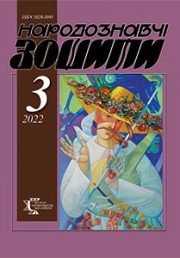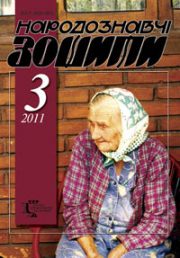The Ethnology Notebooks. 2022. № 3 (165), 657—663
UDK [7.045.011.26:165.412]:393.9(=161.2)
DOI https://doi.org/10.15407/nz2022.03.657
ANTINOMIC GROUPS OF CHARACTERS IN THE STRUCTURE OF THE FUNERAL CYCLE OF RITUALS
KUKHARENKO Oleksandr
- ORCID ID: https://orcid.org/0000-0001-5421-1004
- Candidate of Philological Sciences, Associate Professor,
- Associate Professor Kharkiv State Academy of Culture,
- 4, Bursatsky Descent, 61000, Kharkiv, Ukraine,
- Contacts: e-mail: art-red@ukr.net
Abstract. Antinomies in this study should be understood as opposite pairs of symbols, subjects, topographic objects, as well as polarly directed in their activities characters. An important role in the interaction of pairs of antinomic characters is played by the process of sacralization, which becomes possible as a result of interaction of two worlds — real and the other world.
Starting with the prologue, the main character goes through the path of gaining and losing new statuses in the following sequence: dying — dead — buried — deceased. Each subsequent status forms an antinomy with the previous one. During the movement of the dead to the cemetery, two pairs of antinomic concepts are revealed: the dwelling of the living — the settlement of the dead, the pit — the grave.
From rite to rite, more and more groups of people take part in the ritual action, receiving a certain dose of sacralization. At the same time, those who have already gone through the previous rites are contrasted and represent an antinomic dependence with those who are involved in the ritual action for the first time. So antinomic characters in the prologue are the priest, as a representative of the real world, and the old women who are identified with the afterlife. In the rite of preparation for burial, an antinomic pair is formed between family members of the deceased and neighbors, friends and young people who «guard the soul»; a funeral at home — family and close relatives, a memorial dinner — between the participants of the rite (the real world) and the beggars (the afterlife) who are wined and dined outside.
The last antinomy forces to change the wording of the nature of action in one episode, and to move the culmination from the second episode to the fourth — visiting and wining and dining of the elders. Due to this transformation, the structure of the memorial dinner undergoes fundamental changes, the culmination moves from the beginning of the rite to its end, however the general structure of the whole ritual cycle acquires additional harmony and functionality.
Keywords: Ukrainian ritualism, family rites, funeral rite, structural and functional method, antinomies.
Received 6.06.2022
REFERENCES
- Levi-Stros, K. (1985). Structural antropology. Moskva: Glav. red. vostochnoy literatury [in Russian].
- Gennep, A. (1999). Obryady perekhoda. Sistematicheskoe izuchenie obryadov. Moskva: Vostoch. lit-ra [in Russian].
- Propp, V. (2001). Morfologiia volshebnoi skazki. Moskva: Labirint [in Russian].
- Terner, V. (1983). Simvol i ritual. Moskva: Nauka [in Russian].
- Kukharenko, O. (2018). Funeral Ceremony in the System of Structural-Functional Studies of Family Objectives. Paradigm of Knowledge. Multidisciplinary Scientific Journal, 2, 132—144.
- Kukharenko, O.O., & Kukharenko, A.V. (2019)., Creation of the structure of the cycle of Ukrainian traditional funeral rites. Culture of Ukraine(Issue 64, pp, 185—194) Ukrainian].
- Volkenshtejn, V. (1929). Dramaturgy. Method for the study of dramatic works. Moscow: Federation, [in Russian].
- Baiburin, A.K. (1993). Ritual in Traditional Culture: Structural and Semantic Analysis of East Slavic Rites. St. Petersburg [in Russian].
- Benkovskii, I.F. (1896). Death, burial and afterlife according to the concepts and beliefs of the people. Kievskaja starina, 9, 229—261 [in Russian].
- Guzii, R.B. (2007). From folk thanatology: Carpathian investigations. Lviv: Ethnology Instytut of NAS of Ukraine [in Ukrainian].
- Sventsytskyi, I.S. (1910). Funeral mourning and church-religious poetry. Notes of the Shevchenko Scientific Society (Vol. 93, pp. 32—53; vol. 94, pp. 5—39)[in Ukrainian].
- Sventsytskyi, I.S. (1912). Funeral mourning. Ethnographic collection (Vol. 32, pp. 1—129) [in Ukrainian].






